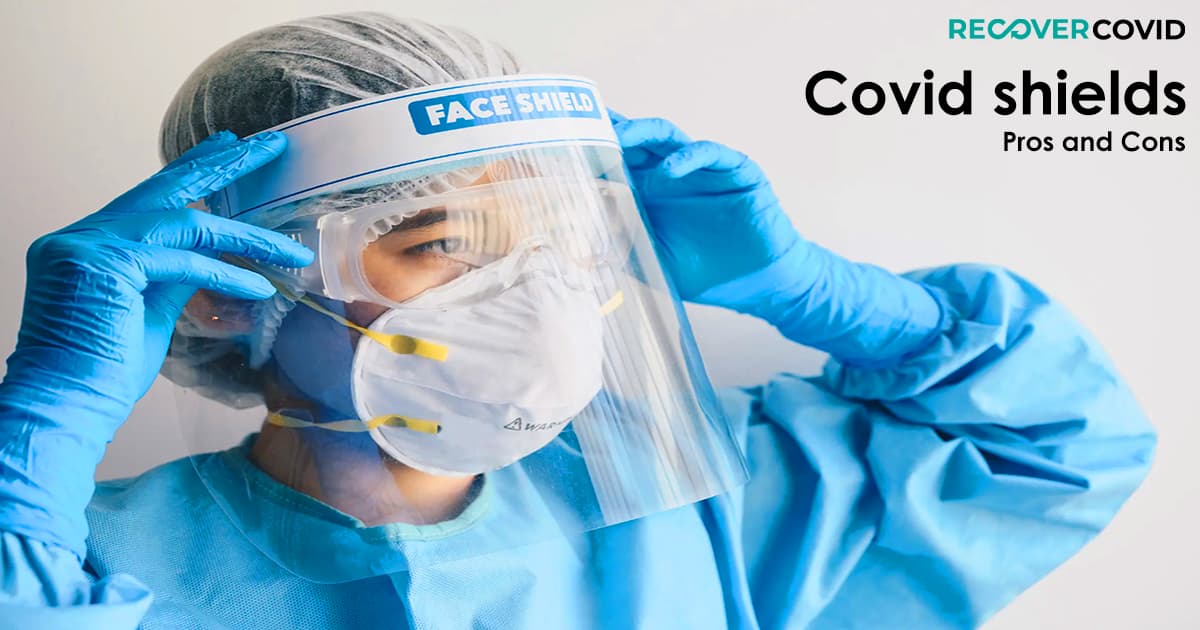Covid shields: Are they safe enough to protect us against Covid-19?

Doctors treating covid-19 patients often wear plastic shields as a part of their protective equipment. In the same manner, face shields for covid 19 became a very important tool against the pandemic outbreak. However, these face shields have also become common in other settings such as bars, beauty salons and shops. In addition, many people use them as an alternative to fabric face masks when they leave the house during the pandemic.
Table of Contents
The pros of the face shields for covid 19

Protect the entire face with face shields for covid 19
Face masks often tend to slip under the nose or sometimes even entirely off the face. Unlike masks, it is challenging to wear a Covid shield incorrectly. You just have to make sure that it is appropriately positioned. According to a health care explainer from the University of Iowa Health, the forehead band should sit ½ inch to 1 inch above the eyebrows, and the bottom of the shield should be below chin level.
Easy to find
Just as cloth masks found everywhere these days, face shields are also readily available from high-end retail shops to convenience stores. You can also easily find them over the internet with a pack of two reusable shields costing between $10 and $20. Whereas more elaborate models will cost you about $50.
The cons of the face shields for covid 19
Check out the latest video why some of the face shields could be problematic during the daily usage.
Not as effective at protecting others
One reason why CDC recommends face masks is that they serve as a “source control”. This means they help prevent the virus from transmitting from people who have covid-19. In addition, the face shields block the respiratory particles from travelling into the air and then to other people. As a result, they can significantly reduce the spread of disease when worn correctly and universally. The face shields also can stop respiratory droplets from spreading to others. However, CDC says it is unclear how.
Uncomfortable
Face shields have a few drawbacks, including the fact that they are pretty uncomfortable. They can be bulky to wear, mainly because the guard wraps around your entire face to maximize protection. They can also fog up. What’s more, people who wear the face shields on top of their masks may often find that they need to speak more clearly or louder while communicating with others. If you find face masks uncomfortable, then adding an extra layer will likely be more painful.
Low-quality models
When buying a face shield, you need to make sure that it provides sufficient coverage. For example, some models only shield the mouth and nose. Likewise, just as face masks, the shields need a bit more routine care for effectiveness. The reusable shields have to be cleaned and disinfected after every use. The wearers of face shields should also wash their hands before and after removing them. In addition, when removing it, avoid touching their eyes, nose and mouth.
Even with face shields and face masks, it is important to follow other guidelines such as avoiding close contact with people outside your home and steering clear of crowded settings—especially indoor spaces where there is poor ventilation. Wash your hands often and disinfect surfaces that are touched often. No amount of personal protective equipment is 100 percent safe!

Covid shields: Are they safe enough to protect us against Covid-19?
Doctors treating covid-19 patients often wear plastic shields as a part of their personal protective equipment. However, these face shields have also become common in other settings such as bars, beauty salons and shops. Many people use them as an alternative to fabric face masks when they leave the house during the pandemic.
Pros
Protect the entire face
Face masks often tend to slip under the nose or sometimes even completely off the face. Unlike masks, it is difficult to wear a covid shield incorrectly. You just have to make sure that it is positioned properly. According to a health care explainer front the University of Iowa Health, the forehead band should sit ½ inch to 1 inch above the eyebrows and the bottom of the shield should be below chin level.
Easy to find
Just as cloth masks found everywhere these days. Face shields are also easily available from high-end retail shops to convenience stores. You can also easily find them over the internet with a pack of two reusable shield costing between $10 and $20. Whereas more elaborate models will cost you about $50.
Cons
Not as effective at protecting others
One reason why CDC recommends face masks is because they serve as a “source control”. This means they help prevent the virus from transmitting from people who have covid-19. The face shields block the respiratory particles from travelling into the air and then to other people. They can significantly reduce the spread of disease when worn correctly and universally. The face shields also have an ability to drop respiratory droplets from spreading to others, however, CDC says it is unclear how.
Uncomfortable
Face shields have a few drawbacks, including the fact that they are quite uncomfortable. They can be bulky to wear, especially because the shield wraps around your entire face to maximize protection. They can also fog up. What’s more, people who wear the face shields on top of their masks may often find that they need to speak more clearly or louder while communicating with others. If you find face masks uncomfortable then adding an extra layer will likely be more uncomfortable.
Low quality models
When buying a face shield you need to make sure that it provides sufficient coverage. For example, there are some models that only shield the mouth and nose. Likewise, just as face masks, the shields need a bit more routine care for effectiveness. The reusable shields have to be cleaned and disinfected after every use. The wearers of face shields should also wash their hands before and after removing it. In addition, when removing it, avoid touching their eyes, nose and mouth.
Even with face shields and face masks, it is important to follow other guidelines such as avoiding close contact with people outside your home and steering clear of crowded settings. Especially indoor spaces where there is poor ventilation. Wash your hands often and disinfect surfaces that are touched often. No amount of personal protective equipment is a 100 percent safe!



